2020 is the year of resilience. Coming out of the bushfires, into COVID-19, Australians have been hit hard. Not to mention the global economy and unrest. Now with parts of Australia in lockdown for a second time, we’ve still got a long journey ahead. This time is testing individuals and businesses with unique, and often crippling, challenges. So, how do we keep going? How do we push through, faced with so much uncertainty? A big part of this lies in resilience.
For further insight, we caught up with Matt Hughes, Founder and Lead Resilience Coach at ripen Psychology. In this interview, Matt tackles topics around the importance of resilience in times of significant change, and offers expert tips to help you and your team build resilience to thrive in the face of adversity.
Let’s get into it.
Hi Matt. Can you tell us a bit about yourself and ripen Psychology?
“I’m Matt Hughes, founder and lead resilience coach at ripen Psychology. And, since 2016, myself and my team at ripen have been helping organisations of diverse industries and size to understand and use resilience for enhancing individual and team performance.
“We do this by delivery of practical courses that train individuals and teams in a proven set of resilience abilities, and those abilities really help people to monitor and maintain resilience for optimal performance. We also profile resilience for recruitment and current development. And, we have behaviour change solutions and consulting for really helping organisations to embed resilience into a team or the organisation’s DNA.”
What is resilience?

“Imagine you put an apple in a vice and wind it up a few times. It’s likely the apple would be squashed under the pressure, right? There’s no getting an apple back to its original shape and size after that.
“Now, imagine we put a tennis ball in the same vice and wound it up the same number of times. The tennis ball likely wouldn’t explode under that same compressive pressure. Instead, when you unwind the vice, the tennis ball will likely rebound back to its original shape and size.
“So, you could say an apple isn’t very resilient under compressive stress, but a tennis ball is. And so, for an object, the definition of resilience is the ability of an object to return to its original shape and size after deformation caused by compressive stress.
“Now, human beings are not objects, but if we use the metaphor of putting things in a vice, then as human beings we all have different limits to the amount of pressure we can take before we explode, so to speak. But, a better definition for the resilience of a person is:
“Resilience is a set of abilities that enable good outcomes in spite of serious threats.”
Why is resilience so important during times of adversity and change?

“No industry, no organisation is immune from the need to rapidly change. Interpersonal and team conflicts are often a result of this change and transformation. But life is inevitably bumpy. We’re going to have these obstacles that come up, and it’s how you view them as to whether you can get past them.
“Unfortunately, some people’s response or action towards a setback may put them in a withdrawal or a negative position. Whereas, some other people might respond to it in a more firm and positive, forward-looking way. It’s how you frame what you’re facing that becomes really important.
“By taking the time to notice that it’s our interpretation of the situation that’s affecting our response and our resilience, we can then choose a better response - as a growth opportunity, a way to learn and become better.”
“It’s not the event, the person or the situation that affects our emotions - it’s our interpretation.”
How can building resilience help people and organisations not just survive, but thrive?

“Resilience has a direct link to optimal performance and wellbeing. Those two things, right now, have a direct link to mental health and wellness. And those are the biggest risk factors for businesses. What’s the mental health of my organisation? How are my people coping mentally through everything that’s being faced? But also, how are they performing well? How are they able to still achieve what we’re trying to do as a business or as a team?
“People with low resilience spend their mental and physical energy worrying about things they can’t do anything about. Whereas, highly resilient people focus on what they can control, what they can influence.”
“Then they think about the actions that they need to take, and then they take action.
“There are individual elements to resilience that are trained to make an individual highly resilient, but resilience is so much more meaningful when it’s developed and shared among the collective team. The collective individual behaviours translate into the team behaviours, which translate into the team outcomes.”
“It is partly about survival, right now. But, done well, resilience equals thriving.”
6 tips for building resilience for high performance
The good news is, there is a core set of skills that can be learned to build resilience for high performing individuals and teams. The following tips can help.
1. Plan how you start your day
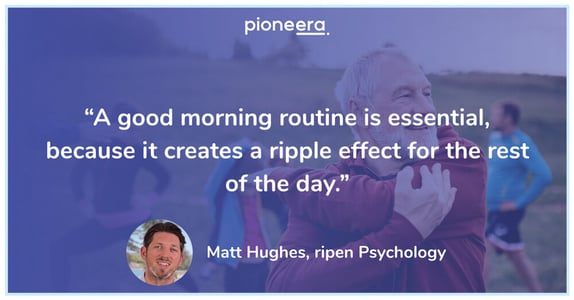
“The minute we open our work emails, we’re on somebody else’s schedule. Our time is being poured into what others need or want. So, how you or your team spend the first hour of the day, or work day, especially when working at home or remotely, can really set the day up for success.
“As much as possible, ensure people begin the day with a simple routine for themselves that gets them in the right state of mind, but also in the right physical state. If they’ve had their breakfast, coffee, exercise, whatever they need to get them setup for the day.”
2. Avoid burnout by managing stress levels
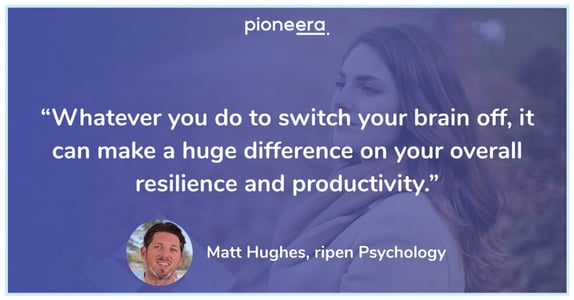
“Army Marines and high-performing athletes are trained to manage their energy by understanding how to effectively spend and recover it. In the workplace, cognitive load occurs when we’ve reached the point that our brains need a mental break. And, you can notice when you’ve reached that point - you start to yawn, you become distracted, you’re unfocused.
“Help yourself and your team pay attention to when they start feeling distracted or unfocused, and schedule as little as 10-15 minutes deliberate downtime every two hours. That’s the sweet spot. That can mean a walk around the block, a quick run, jump on the indoor bike, or sit on the couch with a good book.”
3. Pay attention to your mindset
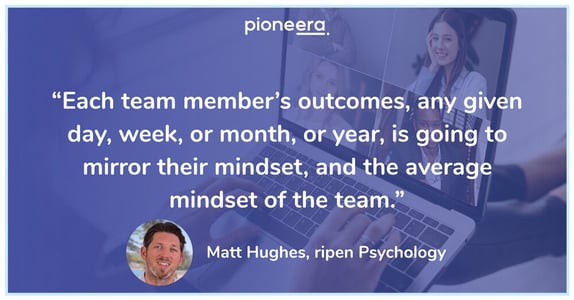
“We can’t easily stop our thoughts, but we can choose which ones we give energy and focus to. We can choose to be in a resourceful frame of mind: ‘I can.’ ‘Let’s try.’ ‘Life is what I make it.’ Or, we can choose to be in an un-resourceful frame of mind: ‘I can’t do this.’ ‘What’s the point?’ ‘Life’s so unfair.’
“Our brains work unconsciously, so it’s really important to find a tool, or training, that enables you to consistently check in with your mindset, and make it a habit, rather than just roughing it and trying to do it on your own.”
4. Dedicate time to building trusted relationships
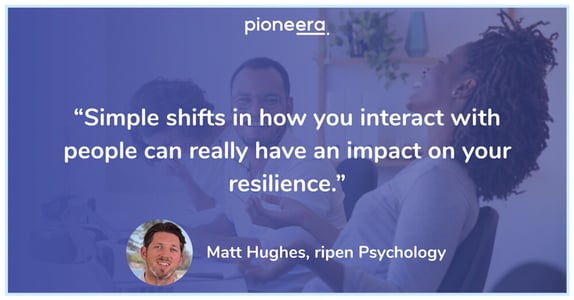
“Having a good support network during tough times is an essential resilience buffer for bouncing back from any adversity, change or setback. Trust is like the oil in the engine of any relationship, i.e. without trust, the relationship doesn’t run properly. Team leaders need to be able to create trust in the team.
“It’s all about making time for getting to know people beyond just work talk, in a genuine way, and avoiding showing too much self-interest. Self-interest is: ‘I want.’ ‘I need.’ ‘Me. Me. Me.’ versus ‘We.’ ‘Us.’ Or… 'How are you doing?’ ‘What can we do to make this better?’ ‘How is this going to impact us?’ Not, ‘how is this going to impact me?’”
5. Open communication during change
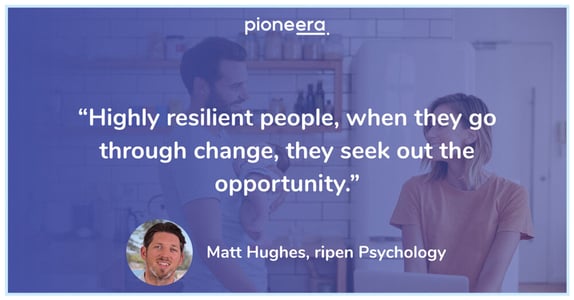
“The hardest change to deal with is change that’s being imposed on us, change we didn’t choose for ourselves. And, the biggest risk factors to our resilience during change is uncertainty about what the change is going to bring.
“Take the time to ensure you or your team discuss and understand the reasons for why the change is happening. Don’t wait to be given information about the change, go out and actually find out information. Not through social media, but within an organisation sense. Go and ask the leaders or the change team about the changes the organisation is going through.
“Getting involved in the change can be a great way to seek out opportunities that the change will inevitably bring. Whereas people who are stuck in an un-resourceful frame of mind end up looking at the change as to all the things that they stand to lose.”
6. Align people’s values (for leaders)

“Misalignment of values and team purpose leads to high conflict and low performance. So, for leaders, it’s essential that you take time to re-group, help everyone understand the purpose of the team, get everyone attached to a clear ‘why’, and, as much as possible, align people’s values. So that you can see you all care for the same things, or you’re all working towards the same thing.
“When some team members are just worried about the bottom line and others are worried about doing right by the customer, you really start to see conflicts, and, therefore, low performance.”
Final thoughts?
“Performance and shareholder returns have always been the biggest concern for many organisations. However, right now, the mental health of an organisation is so critical to even achieving the baseline level of outcomes for a business.
“You need to have a strategy around how you’re going to monitor, maintain, and improve the mental health of the organisation. Because no matter what performance or shareholder value you’re trying to achieve, if your team isn’t mentally well, they’re not going to cope. And if they haven’t got a practical set of resilience abilities to be able to cope with all this change, then the bottom line is going to be affected anyway.”
This conversation was brought to you by Pioneera and Indie.






